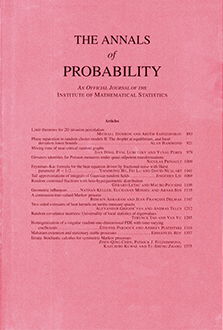Abstract
We consider a model of diffusion in random media with a two-way coupling (i.e., a model in which the randomness of the medium influences the diffusing particles and where the diffusing particles change the medium). In this particular model, particles are injected at the origin with a time-dependent rate and diffuse among random traps. Each trap has a finite (random) depth, so that when it has absorbed a finite (random) number of particles it is “saturated,” and it no longer acts as a trap. This model comes from a problem of nuclear waste management. However, a very similar model has been studied recently by Gravner and Quastel with different tools (hydrodynamic limits). We compute the asymptotic behavior of the probability of survival of a particle born at some given time, both in the annealed and quenched cases, and show that three different situations occur depending on the injection rate. For weak injection, the typical survival strategy of the particle is as in Sznitman and the asymptotic behavior of this survival probability behaves as if there was no saturation effect. For medium injection rate, the picture is closer to that of internal DLA, as given by Lawler, Bramson and Griffeath. For large injection rates, the picture is less understood except in dimension one.
Citation
Gerard Ben Arous. Alejandro F. Ramírez. "Asymptotic survival probabilities in the random saturation process." Ann. Probab. 28 (4) 1470 - 1527, October 2000. https://doi.org/10.1214/aop/1019160496
Information





